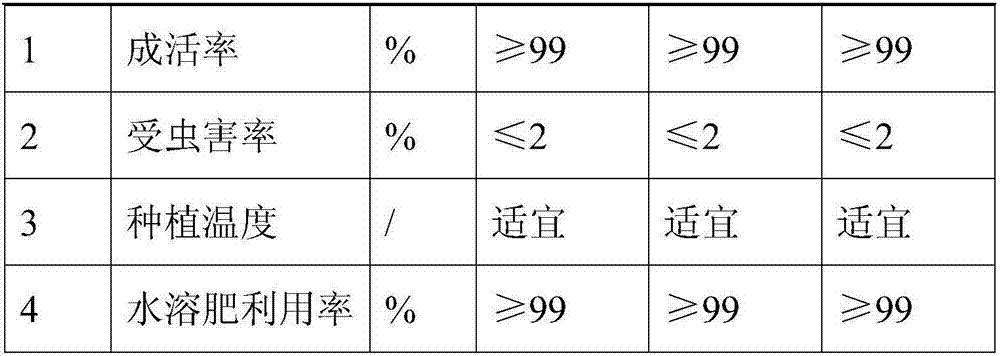Brassica campestris soilless cultivation method
A technology for soilless cultivation and pak choi, which is applied in the directions of soilless cultivation, cultivation, and botanical equipment and methods, can solve the problems of poor nutrient ratio of substrates, difficult control of yield per mu, and provision of nutrients, and achieve vegetable quality. The effect of cleanliness and hygiene, vegetable quality and safety, and increasing growth rate
- Summary
- Abstract
- Description
- Claims
- Application Information
AI Technical Summary
Problems solved by technology
Method used
Image
Examples
Embodiment 1
[0038] The method for soilless cultivation of Chinese cabbage comprises the steps:
[0039] Step 1. Substrate preparation:
[0040] The substrate for soilless cultivation of Chinese cabbage includes the following components in terms of mass parts: 10 parts of perlite, 40 parts of coir peat soil, 30 parts of straw powder, 10 parts of plant residue, 11 parts of wood chips, 10 parts of peanut shells, pig manure 5 parts, 5 parts of vermicompost, 6 parts of peptone, 5 parts of silkworm chrysalis powder, 5 parts of shell powder, 5-10 parts of broad bean leaf bran, mix the above components evenly to obtain the matrix;
[0041] Step 2. Nutrient solution configuration:
[0042] The nutrient solution includes the following components in parts by mass: 150 parts of water, 10 parts of potassium sulfate, 20 parts of urea, 2 parts of sodium molybdate, 10 parts of low-carbon alcohol, 3 parts of indole butyric acid, gibberellin 8 parts, 6 parts of ammonium molybdate, 4 parts of zinc sulfate...
Embodiment 2
[0058] The method for soilless cultivation of Chinese cabbage comprises the steps:
[0059] Step 1. Substrate preparation:
[0060] The substrate for soilless cultivation of Chinese cabbage includes the following components in terms of mass parts: 12 parts of perlite, 44 parts of coir peat soil, 33 parts of straw powder, 13 parts of plant residue, 14 parts of wood chips, 13 parts of peanut shells, pig manure 6 parts, 56 parts of vermicompost, 8 parts of peptone, 6 parts of silkworm chrysalis powder, 8 parts of shell powder, 8 parts of broad bean leaf bran, mix the above components evenly to obtain the matrix;
[0061] Step 2. Nutrient solution configuration:
[0062] The nutrient solution includes the following components in parts by mass: 170 parts of water, 13 parts of potassium sulfate, 22 parts of urea, 3 parts of sodium molybdate, 12 parts of low-carbon alcohol, 4 parts of indole butyric acid, gibberellin 9 parts, 8 parts of ammonium molybdate, 6 parts of zinc sulfate, ...
Embodiment 3
[0078] The method for soilless cultivation of Chinese cabbage comprises the steps:
[0079] Step 1. Substrate preparation:
[0080] The substrate for soilless cultivation of Chinese cabbage includes the following components in terms of mass parts: 13 parts of perlite, 50 parts of coir peat soil, 35 parts of straw powder, 15 parts of plant residue, 16 parts of wood chips, 15 parts of peanut shells, pig manure 7 parts, 7 parts of vermicompost, 10 parts of peptone, 7 parts of silkworm chrysalis powder, 10 parts of shell powder, 10 parts of broad bean leaf bran, mix the above components evenly to obtain the matrix;
[0081] Step 2. Nutrient solution configuration:
[0082] The nutrient solution includes the following components in parts by mass: 180 parts of water, 15 parts of potassium sulfate, 24 parts of urea, 4 parts of sodium molybdate, 13 parts of low-carbon alcohol, 5 parts of indole butyric acid, gibberellin 10 parts, 10 parts of ammonium molybdate, 8 parts of zinc sulfa...
PUM
 Login to View More
Login to View More Abstract
Description
Claims
Application Information
 Login to View More
Login to View More - R&D
- Intellectual Property
- Life Sciences
- Materials
- Tech Scout
- Unparalleled Data Quality
- Higher Quality Content
- 60% Fewer Hallucinations
Browse by: Latest US Patents, China's latest patents, Technical Efficacy Thesaurus, Application Domain, Technology Topic, Popular Technical Reports.
© 2025 PatSnap. All rights reserved.Legal|Privacy policy|Modern Slavery Act Transparency Statement|Sitemap|About US| Contact US: help@patsnap.com


